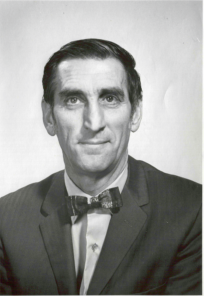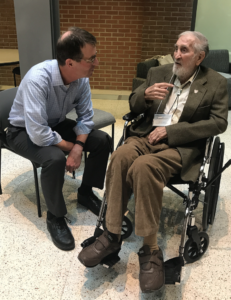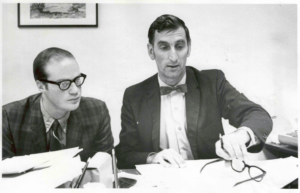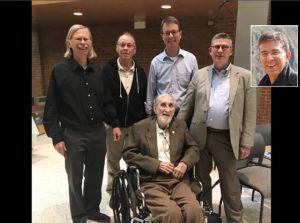
U-M Economist, Research Scientist and ISR Founding Member James N. Morgan Dies at 99
January 10, 2018
 James N. Morgan, an economist who created the longest-running intergenerational household survey in the world, died on January 8, 2018 at University of Michigan Hospital in Ann Arbor, Mich. He was 99 and lived in Ann Arbor.
James N. Morgan, an economist who created the longest-running intergenerational household survey in the world, died on January 8, 2018 at University of Michigan Hospital in Ann Arbor, Mich. He was 99 and lived in Ann Arbor.
Morgan was a great believer in new ideas and worked with other economists, such as Nobel Prize winner James Tobin, on issues of income and income support systems. As an early scholar, he was interested in the factors shaping various outcomes such as how much a family spent on housing, factors leading to early retirement or non-market activity and other forms of time allocation. His work challenged the prevailing belief that those in poverty were destined to stay in poverty, arguing instead that the majority of poor families emerge from bad times and achieve middle income status.
“Jim’s intellectual energy was enormous. It fueled a wealth of path-breaking contributions to our understanding of the world, and introduced new methods for generating more knowledge and deepening that understanding,” says Morgan’s former student turned long-time colleague, Greg Duncan, Professor of Education at University of California, Irvine. “But Jim also displayed a lifelong commitment to an analytical form of social justice, which triggered many acts of kindness as well as windmill tilting.”

Greg Duncan (left) with James Morgan at the 50th Anniversary Celebration of the Panel Study of Income Dynamics on September 14, 2017. Photo by Michael McIntyre/ISR.
“He also believed in the power of inductive discovery and felt observing what occurred can serve as the basis for understanding,” says Frank Stafford, Research Professor at the Institute for Social Research and Professor of Economics at the University of Michigan. “Even within the financial domain he observed strong synergies between the traditional economic variables of income, assets and life insurance.”
Morgan came to the University of Michigan (U-M) in 1949 as a postdoctoral fellow in economics, where he became a founding member of the University’s Institute for Social Research (ISR). He retired in 1997 as a research scientist emeritus and professor emeritus of economics.
David Lam, Director of the Institute, remembers Morgan as being one of the most creative and generative thinkers in the ISR Founders generation. “This was not just for his substantive innovation, but for his methodological innovation as well,” says Lam.
After retirement, Morgan continued to be a regular presence at ISR and the University, and he regularly wrote on economic issues of particular concern, such as income disparity. In 2013, he set up a fund at ISR in his name to support graduate students in making innovative use of SEARCH, a survey data analysis program he created in the 1960s.
Though supported by the National Science Foundation and published in the Journal of the American Statistical Association, Morgan’s SEARCH approach to complex data was too different for many researchers to embrace; the research community continued to favor the classic method of hypothesis testing from a given conceptual framework. But the method found favor in the business and policy worlds, and in recent years was given new life by the analysis demands of Big Data. In 2014, Jim’s pioneering work was recognized in a paper by Hal Varian in the Journal of Economic Perspectives entitled “New Tricks in Econometrics.”
Morgan was born near Corydon, Indiana, in 1918. He received his bachelor’s degree from Northwestern University in 1939, and his master’s degree and Ph.D. in economics from Harvard University in 1941 and 1947. The outbreak of World War II delayed the completion of Morgan’s graduate education: as a conscientious objector, he spent three-and-a-half years at the North Appalachian Experimental Watershed of the Soil Conservation Service in Coshocton, Ohio, where he used his research skills to analyze factors affecting crop yields. The methods used by the agricultural scientists were the inspiration for his SEARCH program.
Morgan became an assistant professor at Brown University in 1947. After his arrival at U-M in 1949, he was appointed an assistant program director of ISR’s Survey Research Center in 1951, and he became a program director in 1956. Morgan was appointed associate professor of economics in 1953, and professor of economics in 1958.

Richard Barfield (left) and Morgan in the late 1960s at the Institute for Social Research.
In 1968, Morgan conceived of and launched the Panel Study of Income Dynamics (PSID), an ISR study created to track household data for the same 18,000 individuals over time. The study proved vital and increasingly far reaching. In the years since, PSID has continuously collected data covering employment, income, wealth, expenditures, health, marriage, and other topics; it’s now following more than 77,000 members across four generations of some 11,000 families. In addition, it has served as the model for intergenerational studies in countries including the United Kingdom, Germany, Israel, Australia, Singapore, and China.
This year, PSID celebrates its 50th anniversary. The National Science Foundation voted it one of its “Nifty Fifty” and “Sensational Sixty” NSF-supported projects because of its impact on research about families and their finances. “Methodologically, PSID was one of the early studies that demonstrated the impact of the social sciences,” says Lam.

Directors of the PSID, (from left) Charlie Brown, Frank Stafford, Greg Duncan, David Johnson and Founding Director James Morgan, seated. Bob Schoeni inset. Photo by Michael McIntyre/ISR.
Recently, Jim established the James Morgan Innovation in the Analysis of Economic Behavior Fund to encourage U-M graduate students to use Panel Study on Income Dynamics data in new and original ways.
“An academic’s best hope for immortality rests with the wisdom imparted to graduate students, which is, in turn, passed on to the students of those students, and so on. I find myself channeling Jim’s wisdom and kindness often as I continue to mentor new generations of students,” says Duncan.
Morgan was a fellow at Stanford University’s Center for Advanced Study in the Behavioral Sciences. In 1975, he was elected to the National Academy of Sciences. He was also a Fellow of the American Statistical Association, the Gerontological Society of America, and the American Academy of Arts and Sciences. The University of Michigan gave him the Distinguished Faculty Achievement Award in 1977.
Morgan is survived by four children, Salim, Ken, Tim, and Janet; 10 grandchildren; and 20 great-grandchildren.
At the request of his family, gifts in memory of Jim can be made to the James Morgan Innovation in the Analysis of Economic Behavior Fund.
Please read more about Jim Morgan’s distinguished career and his personal and professional impact on those who worked with him: Jim Morgan: In Memoriam (PDF).
By Patrick Shields
Contact
You may also want to read
Rich get richer: U-M study shows changes in income, spending of America’s families
Exceptional upward mobility in the U.S. is a myth, international studies show
